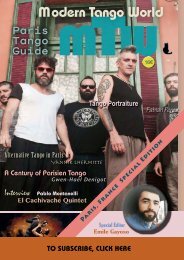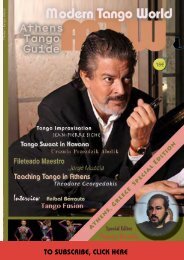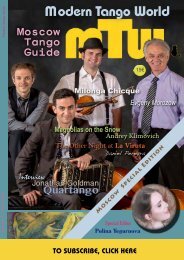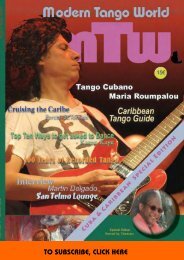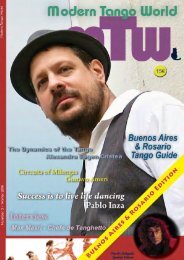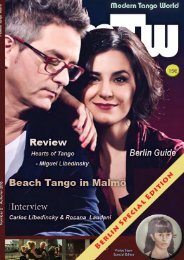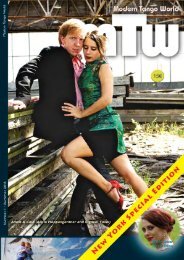Modern Tango World #9 (Rome, Italy)
Rome Special Features Symbolic Roman Tango Places Mario Abbati 03 Milongas in Rome Enrico Colagrossi 08 Roman Tango, 1980 to Present Emanuela (Mela) Molinari 13 Roman Road to NeoTango Elio Astor 16 Guide to Tango in Rome 20 Endless Tango William Hudson Temples 26 Interview with Mariano Mattone (Tangothic) Raymond Lauzzana 30 Visual dancing Andreas Lange 33 From León to Patagonia and Back Eduardo Delgado Hernández 36 New Tango Music Arndt Büssing 40 Tango Moves: Ochos (Figure Eights) Raymond Lauzzana 44
Rome Special Features
Symbolic Roman Tango Places Mario Abbati 03
Milongas in Rome Enrico Colagrossi 08
Roman Tango, 1980 to Present Emanuela (Mela) Molinari 13
Roman Road to NeoTango Elio Astor 16
Guide to Tango in Rome 20
Endless Tango William Hudson Temples 26
Interview with Mariano Mattone (Tangothic) Raymond Lauzzana 30
Visual dancing Andreas Lange 33
From León to Patagonia and Back Eduardo Delgado Hernández 36
New Tango Music Arndt Büssing 40
Tango Moves: Ochos (Figure Eights) Raymond Lauzzana 44
You also want an ePaper? Increase the reach of your titles
YUMPU automatically turns print PDFs into web optimized ePapers that Google loves.
Roman <strong>Tango</strong>, 1980 to the Present<br />
Emanuela (Mela) Molinari<br />
During the 1980s in <strong>Rome</strong>, and more generally in <strong>Italy</strong>, one had to search a great deal to find tango. The<br />
same was true in Argentina. The The musical trends before and during the dictatorship had accelerated<br />
the decline. Beyond the popular worship for Gardel, only the abnormal figure of Astor Piazzolla was<br />
recognized in the rest of the world beyond the banks of the Rio Plata. The wotk of Piazzolla became<br />
synonymous with tango as it resounded in the cultural pages and concert halls of the world.<br />
It was the era of the lambada and caribbean rhythms,<br />
with offer of lessons and soaring evenings. For those with<br />
a curiosity for tango, they would need to be content<br />
with the ballroom version, the genre designed for use<br />
and consumption by competitions. While in the record<br />
stores, Piazzolla could be found cataloged among the<br />
orchestras. Some compilation of tangos might be found<br />
in the for export section.<br />
In this deserted landscape<br />
some tiny candles<br />
glowed in <strong>Rome</strong>. For<br />
example at the Argentine<br />
House, the cultural<br />
center of the Argentine<br />
embassy, Carlos Valles<br />
gave lessons. At the FAO<br />
(Food and Agriculture<br />
Organization) there was<br />
a group of amateurs that<br />
held popular balls with<br />
a repertoire of tango<br />
mixed with folk dances,<br />
A less contaminated environment<br />
could be found at Charango, an Argentine<br />
restaurant whose program sporadically included tango,<br />
but only as a musical presentation.<br />
In the mid-1980s, a decisive first impetus was given by<br />
Silvia Vladimivsky, a theatrical dance choreographer in<br />
<strong>Italy</strong>. She came to <strong>Italy</strong> with a scholarship, and held expressive<br />
workshops on tango elements in several cities,<br />
including Turin, Trieste and Naples, n addition to <strong>Rome</strong>,<br />
where she resided. Her work developed a a group of<br />
enthusiastic followers who practiced theater and/or<br />
dance on an amateur level. Some. like the very young<br />
Claudia Koll, became professionals and contributed to<br />
promoting tango through performance in theatrical,<br />
musical and dance circuits.<br />
At the same time, two Italians, Eliana Montanari and<br />
Mitzi Barbacini, of the FAO group, sought to expand<br />
their experience by involving other teachers that they<br />
had met. Eliana became an assistant to Helene Pede,<br />
a German dancer who had moved to <strong>Rome</strong> to teaching<br />
both the leader and the follower roles She had<br />
collaborated with Eduardo Arquimbau on his tours in<br />
Europe. Germany was about ten years ahead of <strong>Italy</strong>, at<br />
the time, Mitzi formed a professional partnership with<br />
Tito Larosa, an Argentine who offered a type of dance<br />
that today would be called Salon.<br />
This is how things were in 1992, when a multifunction<br />
cultural center, Maggiolina, held a three-month tango<br />
review with an extensive programm.<br />
— 15 —<br />
TO SUBSCRIBE, CLICK HERE




